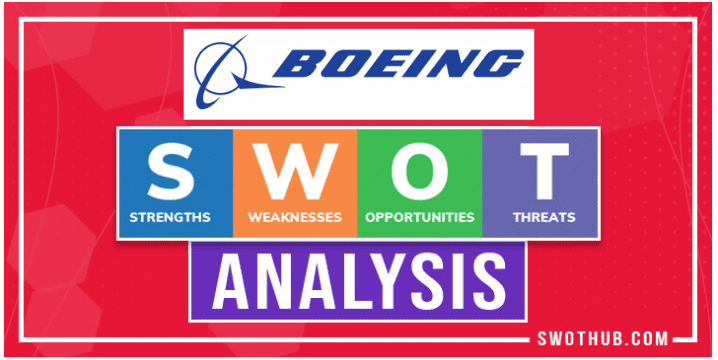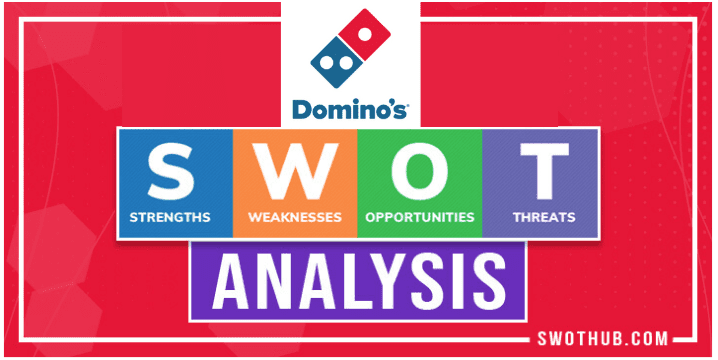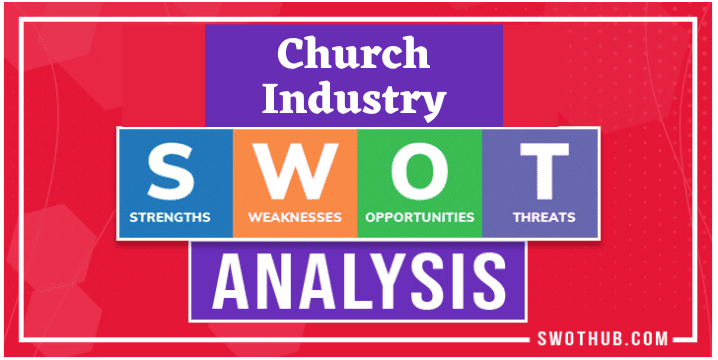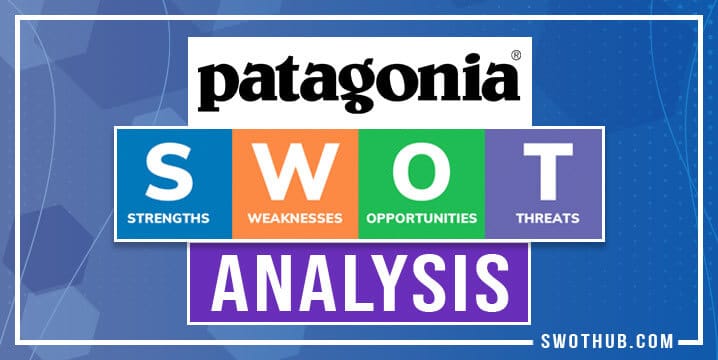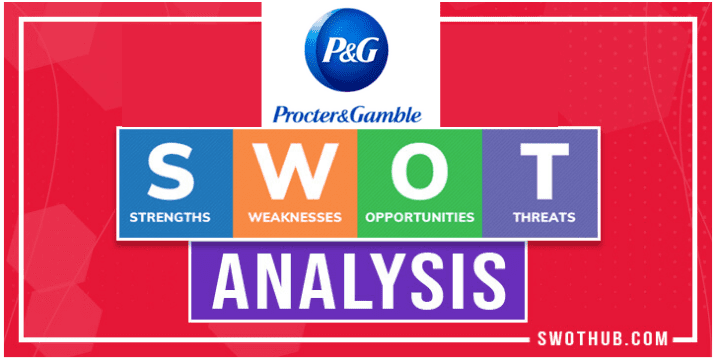The airline industry has seen its ups and downs throughout the years, especially recently from the pandemic. This Boeing SWOT analysis looks at how they have been able to stay ahead of Boeing competitors with excellent customer service and continue to bring iconic aircraft technology to the masses. Although, they have had great accomplishments Boeing threats and Boeing weaknesses surely exist. Look at how Boeing strengths and Boeing opportunities are still available against Boeing competitors.
Table of Contents
Boeing History
In a Boeing SWOT analysis, Boeing is a well-known multinational company that produces missiles, satellites, rockets, aircrafts, and telecommunications equipment all over the world. The company was founded in 1916 by William E. Boeing in Seattle, Washington, has since grown to become one of the most renowned aerospace companies worldwide. First known as Pacific Aero Products Company and then changed to Boeing Airplane Company in 1917.
What is Boeing Most Famous For?
Boeing’s success can be attributed to several important elements, including its long history of innovation and its capacity for change. Boeing has consistently shown over the years that it is dedicated to advancing the aviation industry and has an innovative spirit. Boeing has consistently been at the forefront of aviation innovation, from the Boeing Model 40A, which made history as the first commercial aircraft to fly over the United States in 1927, to the Boeing 787 Dreamliner, which boasts cutting-edge technology like touch-screen displays and electric window tinting.
Another factor that has contributed to Boeing’s success is its strong relationship with its customers. Boeing has always prioritized customer satisfaction, providing excellent service and support to ensure their continued loyalty. This commitment to customer service has helped Boeing build a loyal customer base and has allowed the company to maintain a dominant market position.
In order to further strengthen its capabilities and market position, Boeing has also formed strategic alliances and acquisitions by capitalizing on its strong brand and reputation. For instance, the company gained a bigger competitive advantage over its rivals when it merged with McDonnell Douglas in 1997 to become the largest aerospace company in the world.
Finally, Boeing‘s success can also be attributed to its ability to adapt to changing market conditions. The company has consistently demonstrated an ability to anticipate and respond to market trends, developing new products and services to meet the evolving needs of its customers. This ability to adapt has allowed Boeing to remain competitive in an increasingly challenging and dynamic marketplace.
Boeing’s success can be attributed to a combination of innovation, customer service, strategic partnerships and acquisitions, and an ability to adapt to changing market conditions.
Boeing SWOT Analysis At-A-Glance
| Company | Boeing |
| Industry | Airlines |
| Founder | William E. Boeing |
| Year founded | 1916 |
| CEO | Dave Calhoun |
| Headquarters | Arlington, Virginia |
| Number of employees | 156,000+ (2022) |
| Revenue (FY 2022) | US $66.61 Billion (2022) |
Boeing SWOT Analysis:
A SWOT analysis is a framework used to assess a company’s competitive situation and to create strategic planning. By taking Boeing’s strengths, and weaknesses of Boeing’s threats of Boeing as well as opportunities of Boeing into account, we may better gain in-depth knowledge about Boeing company. In this article, we’ll be taking a look at Boeing’s SWOT framework to better understand its competitive position and potential for future growth. See how Boeing competitors fare against them and learn about Boeing’s Strengths, weaknesses, opportunities, and Boeing threats.
Boeing SWOT Analysis Strengths:
The areas where a company excels above average or in a manner that distinguishes it from its rivals are its strengths. Boeing strengths are outlined in this Boeing SWOT analysis. In a SWOT analysis of Boeing, some of its strengths compared to competitors include:
Strong Brand Image: Boeing is a well-established brand in the aerospace industry, with a long history of producing high-quality aircraft. The company’s brand image is recognized around the world, which gives it an advantage over smaller or newer competitors.
Technological Expertise: Boeing has a solid reputation for technological know-how and innovation in the aerospace sector, according to a Boeing SWOT analysis. The business makes substantial investments in R&D to produce cutting-edge aircraft designs that can set it apart from rivals.
Diversified Business Operations: Boeing has a diverse range of business operations, which includes commercial aircraft, defense, space, and services. This diversification helps to mitigate risks and reduces the company’s reliance on any one sector of the market.
Global Reach: Boeing has a strong global presence, with operations and customers around the world. This helps the company to tap into new markets and reach a wider customer base.
Supply Chain Management: With a solid supply chain management system in place, Boeing is able to efficiently source and oversee the parts and materials required to build its aircraft. In this Boeing SWOT analysis, it may be able to cut expenses and raise the caliber of its output as a result.
Boeing SWOT Analysis Weaknesses:
Weaknesses of a company are those that limit its potential, make it less competitive, and prevent it from achieving its goals. In this section of the Boeing SWOT analysis, we’ll look at Boeing’s strengths before moving on to some of Boeing’s weaknesses. In a Boeing SWOT analysis, some of their weaknesses compared to competitors include:
Dependence on the 737 MAX: The two fatal crashes that led to the 737 MAX’s grounding have been a major setback for Boeing. Relying so heavily on this model has been a weakness for the company, as it has hurt both its reputation and financial results.
Delayed Development Programs: Boeing has faced delays in the development of some of its key programs, such as the 777X and the KC-46 tanker. These delays have not only impacted the company’s financial performance but have also led to concerns among customers and investors.
Supply Chain Disruptions: Boeing’s complex supply chain may be a weakness as delays and production schedule impacts may result from supply chain disruptions. This flaw has been brought to light by the COVID-19 pandemic, which has disrupted the industry’s supply chain.
Pricing Pressure: Because of fierce competition in the aerospace sector, Boeing is under pressure to lower its prices. Because it must strike a balance between the need for profitability and the need to maintain competitiveness, the company’s pricing strategies may be a Boeing weakness.
Labor Relations: Boeing has faced labor relations issues in the past, including strikes by its employees. These issues can impact the company’s ability to maintain production schedules and deliver aircraft on time.
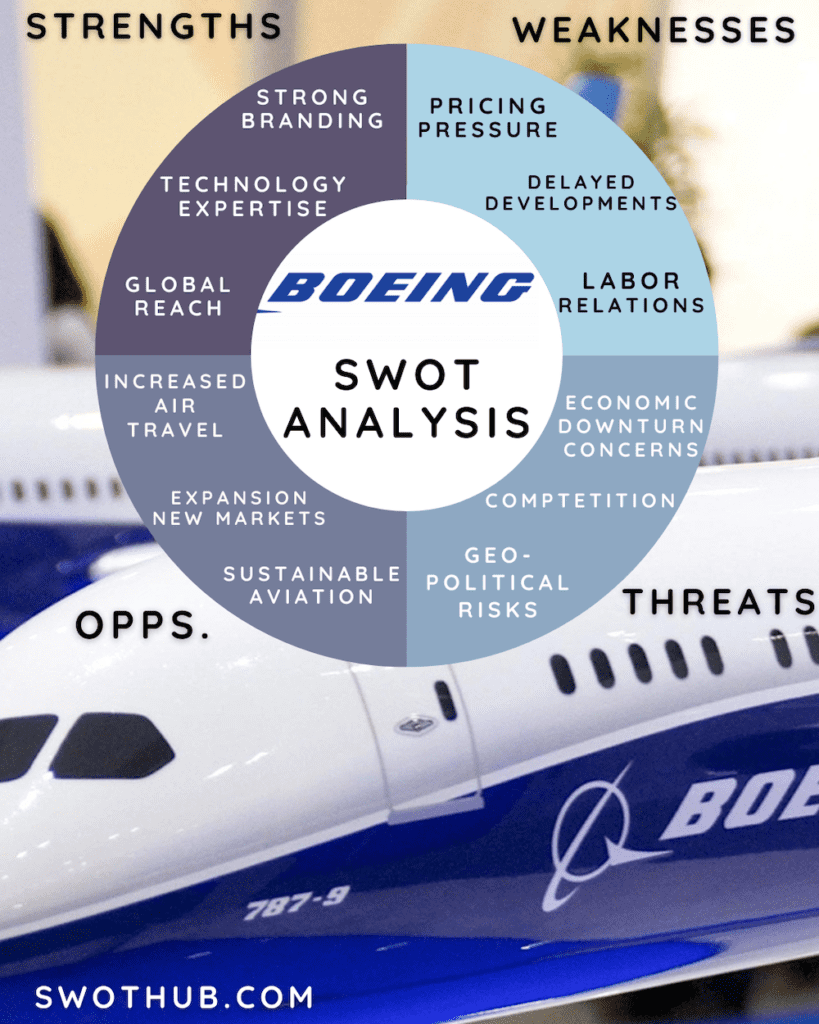
Boeing SWOT Analysis Opportunities:
Boeing exists in a world full of opportunities. The following portion of the Boeing SWOT analysis will examine some of Boeing’s opportunities compared to competitors include:
Increasing Demand for Air Travel: The global demand for air travel is expected to increase in the coming years, which presents an opportunity for Boeing to increase its sales of commercial aircraft.
Development of New Technologies: Boeing has the chance to develop and invest in cutting-edge technologies that could enhance the effectiveness, security, and performance of its aircraft. This may give the business a competitive advantage over rivals and enable it to better serve customers’ changing needs.
Expansion in Emerging Markets: Boeing can expand its business operations in emerging markets, such as Asia and Africa, where there is growing demand for air travel. This can help the company to tap into new markets and reach a wider customer base.
Growing Demand for Military Aircraft: Additionally, it is anticipated that there will be an increase in the demand for military aircraft globally in the upcoming years, giving Boeing an opportunity to boost its defense industry sales.
Shift to Sustainable Aviation: The aviation industry is placing more and more emphasis on sustainability, which gives Boeing the chance to invest in new techniques and technologies that can lessen its impact on the environment and satisfy customers’ changing needs. In a Boeing SWOT analysis, this shift would be a huge leap forward for Boeing against its competitors.
Boeing SWOT Analysis Threats:
Threats pose a risk to every company’s stability and profitability. This article on the Boeing SWOT analysis will address some of the threats that are important to examine.
In a SWOT analysis of Boeing, some of its largest threats compared to competitors include:
Intense Competition: Boeing is up against fierce competition from both newcomers like COMAC and established players like Airbus and Lockheed Martin in the aerospace sector. Pricing pressure, a loss of market share, and decreased profitability may be the effects of this competition.
Economic Uncertainty: The global economy’s fluctuations affect the aerospace sector. Economic turbulence may affect the demand for commercial and military aircraft, which may lead to a decline in orders for Boeing and other aerospace firms.
Technological Disruption: Rapid technological development may cause the aerospace sector to collapse and pose new risks to Boeing. For instance, the emergence of electric and autonomous aircraft could upend the conventional commercial aircraft market and affect consumer demand for Boeing’s goods.
Geopolitical Risks: Boeing is vulnerable to geopolitical risks like shifting trade laws, political unrest, and armed conflicts. These risks may have an effect on the business operations and financial performance of the company.
Safety and Regulatory Risks: The aerospace industry is highly regulated, and safety concerns can impact the reputation and financial performance of companies in the industry. The grounding of the 737 MAX following two fatal crashes is an example of how safety and regulatory risks can impact Boeing’s business.
Boeing Competitors:
In a SWOT analysis of Boeing, its competitors would fall under the “threats” category. Here are some of Boeing’s main competitors in the aerospace industry. Many people ask:
Who is Boeing’s Biggest Competitor?
Airbus: The European-based company is one of the largest aircraft manufacturers in the world and is a direct competitor of Boeing. Airbus is a world leader in the aerospace sector, with operations in the commercial aviation, helicopter, defense, and space industries. In terms of developing, producing, and providing customers with aerospace goods, services, and solutions on a global basis, Airbus is a market leader.
Other Boeing Competitors Include:
Lockheed Martin: While not a direct competitor in the commercial aircraft market, Lockheed Martin is a major player in the defense and military aerospace industry and competes with Boeing for government contracts.
Embraer: The Brazilian aerospace company is a smaller competitor in the commercial aircraft market, but has a strong presence in the regional jet market.
Bombardier: Another Canadian aerospace company, Bombardier, produces regional jets and business aircraft and competes with Boeing in the commercial aircraft market.
COMAC: The Commercial Aircraft Corporation of China is a state-owned aerospace company that is rapidly expanding in the commercial aircraft market, and is seen as a potential threat to Boeing’s dominance in the industry.
It’s crucial to remember that the aerospace sector’s competitive landscape is fluid, and new Boeing competitors could appear at any time.
Boeing SWOT Analysis – Conclusion and Recommendations:
Boeing needs to focus on a number of key strategies to remain competitive in the aerospace industry.
- Boeing should consider diversifying its product portfolio to reduce its reliance on the 737 MAX and mitigate risks associated with delays and safety concerns.
- In this Boeing SWOT analysis, they should focus on sustainability by investing in new technologies and practices that can reduce its environmental impact and meet evolving regulatory requirements.
- Boeing should consider expanding its business operations in emerging markets such as Asia and Africa can help the company tap into new markets and reach a wider customer base.
- Investing in the development of new technologies can help Boeing stay ahead of competitors and meet the evolving needs of customers.
Finally, ensuring Boeing maintains strong labor relations and safety practices will be key to maintaining the trust and loyalty of customers, investors, and employees. By considering these recommendations, Boeing can position itself for success now and in the future.

